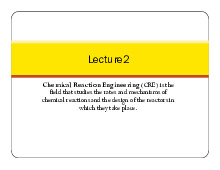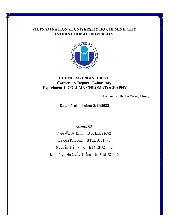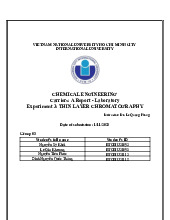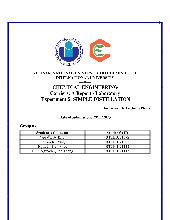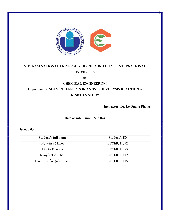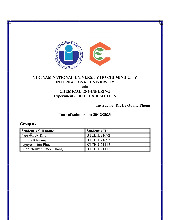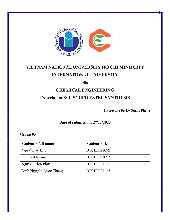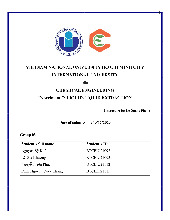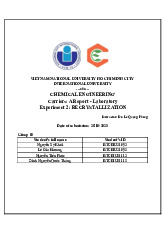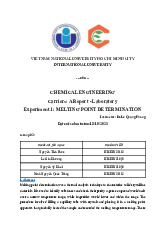Chemical Engineering
Danh sách Tài liệu
-
Lecture 02: Mole Balance and Reactor Sizing Overview | Môn Chemical Engineering - Trường Đại học Quốc tế, Đại học Quốc gia Thành phố Hồ Chí Minh
81 41 lượt tải 52 trangLecture 02: Mole Balance and Reactor Sizing Overview Môn Chemical Engineering. Tài liệu được sưu tầm gồm 53 trang, giúp bạn ôn tập tốt hơn. Mời các bạn đón xem.
Danh mục: Trường Đại học Quốc tế, Đại học Quốc gia Thành phố Hồ Chí MinhMôn: Chemical EngineeringDạng: Bài giảngTác giả: Linh Giang3 tháng trước -
A Report - Laboratory experiment 4 : Column chromatography| Bài báo cáo học phần Chemical Engineering | Trường Đại học Quốc tế, Đại học Quốc gia Thành phố Hồ Chí Minh
332 166 lượt tải 7 trangTo ensure uniform packing of the beads, cotton wool was introduced at the column's base along with the stationary phase. The beads were then added either as a slurry or in a dry state. The mobile phase complements the stationary phase and entered the chromatographic system through the injector. Elution was achieved using solvents selected based on their polarity, employing either isocratic or gradient elution techniques. In the latter, a range of solvents with varying polarities was used. Eluates were detected through the measurement of parameters utilizing visible UV. Tài liệu giúp bạn tham khảo, ôn tập và đạt kết quả cao. Mời bạn đón xem.
Danh mục: Trường Đại học Quốc tế, Đại học Quốc gia Thành phố Hồ Chí MinhMôn: Chemical EngineeringDạng: Báo cáoTác giả: VietJack1 năm trước -
A Report - Laboratory experiment 3 : Thin Layer Chromatography | Bài báo cáo học phần Chemical Engineering | Trường Đại học Quốc tế, Đại học Quốc gia Thành phố Hồ Chí Minh
257 129 lượt tải 8 trangThe process of Thin Layer Chromatography allows compounds to rise on a TLC plate through capillary action as the chromatogram develops. Depending on the polarity of the solvent and how tightly bonded the compounds are to the stationary phase figure out how far the compound will rise the TLC plate. Using the TLC plates, the Rf values were calculated for each of the solutions. With these Rf values, the unknown sample was identified by comparing the other Rf values. The discussion encompasses the several types of stationary phase, including silica gel, alumina, and cellulose, and their respective applications in different chemical systems. Chromatography is based on the principle where molecules in a mixture are applied onto the surface or into the solid, and fluid stationary phase. Tài liệu giúp bạn tham khảo, ôn tập và đạt kết quả cao. Mời bạn đón xem.
Danh mục: Trường Đại học Quốc tế, Đại học Quốc gia Thành phố Hồ Chí MinhMôn: Chemical EngineeringDạng: Báo cáoTác giả: VietJack1 năm trước -
A Report - Laboratory experiment 5 : Simple distillation | Bài báo cáo học phần Chemical Engineering | Trường Đại học Quốc tế, Đại học Quốc gia Thành phố Hồ Chí Minh
329 165 lượt tải 7 trangIn this method, the test tube contained liquids that had a much higher boiling point. Simple distillation was useful for separating liquids that had an enormous difference in boiling points, such as water and salt, or ethanol and water. However, it was not effective for separating liquids that had similar boiling points, such as ethanol and acetone, or benzene or toluene. For these mixtures, had to use other methods, such as fractional or steam distillation. Tài liệu giúp bạn tham khảo, ôn tập và đạt kết quả cao. Mời bạn đón xem.
Danh mục: Trường Đại học Quốc tế, Đại học Quốc gia Thành phố Hồ Chí MinhMôn: Chemical EngineeringDạng: Báo cáoTác giả: VietJack1 năm trước -
A Report - Laboratory experiment 9 : Solvent effects in an SN1 solvolsis reaction a kinetics study | Bài báo cáo học phần Chemical Engineering | Trường Đại học Quốc tế, Đại học Quốc gia Thành phố Hồ Chí Minh
506 253 lượt tải 9 trangThe influence of solvents is of the highest priority in SN1 reactions, especially in solvolysis processes. These reactions include the substitution of a molecule with the aid of a solvent molecule that acts as a nucleophile. The kinetics study of SN1 solvolysis includes examining the influence of variations in solvent type, concentration, and characteristics on the reaction rate. Then can gain insights into how solvent effects impact reaction speeds and processes by conducting experiments that use different solvents with varying characteristics. The study generally entails graphing reaction rates in relation to various solvent characteristics, such as polarity and nucleophilicity, in order to identify patterns and associations. Tài liệu giúp bạn tham khảo, ôn tập và đạt kết quả cao. Mời bạn đón xem.
Danh mục: Trường Đại học Quốc tế, Đại học Quốc gia Thành phố Hồ Chí MinhMôn: Chemical EngineeringDạng: Báo cáoTác giả: VietJack1 năm trước -
A Report - Laboratory experiment 6 : Reflux reaction| Bài báo cáo học phần Chemical Engineering | Trường Đại học Quốc tế, Đại học Quốc gia Thành phố Hồ Chí Minh
319 160 lượt tải 9 trangReflux is a process that entails heating a mixture or solution inside a closed container, such as a flask, and then condensing the vapors. After that, the condensed liquid is then returned to the system to either heat up again or react with other chemicals. This experiment can be used to keep the temperature and product or reactant concentrations constant, particularly when the reaction is slower or demands elevated temperatures. When heating solution in an open vessel will result in solvent loss; however, a reflux apparatus prevents this. The reactant concentration is maintained at all times in a reflux setup because the condenser remains solvent vapors. Reflux can also help in clearing the reaction mixture of undesirable products or contaminants. The flask contains the reaction mixture, the condenser cools down the vapors and returns them to the flask, and the heat maintains the boiling point of the solvent or solution. Tài liệu giúp bạn tham khảo, ôn tập và đạt kết quả cao. Mời bạn đón xem.
Danh mục: Trường Đại học Quốc tế, Đại học Quốc gia Thành phố Hồ Chí MinhMôn: Chemical EngineeringDạng: Báo cáoTác giả: VietJack1 năm trước -
A Report - Laboratory experiment 8 : Fischer estersynthesis | Bài báo cáo học phần Chemical Engineering | Trường Đại học Quốc tế, Đại học Quốc gia Thành phố Hồ Chí Minh
298 149 lượt tải 10 trangFischer esterification, also known as the synthesis of ester, is a chemical process in which an ester is formed by heating a carboxylic acid and an alcohol together in the presence of an acid catalyst. Alcohol is commonly used as a solvent and, as a result, is found in significant quantities. Various acids, including sulfuric acid and poisonous acid, can serve as catalysts. In the process of esterification, a tetrahedral carbonyl addition intermediate is formed, which subsequently eliminates a water molecule to yield the ester. Ester is one of the most common derivatives of carboxylic acids and is widely used distributed in both nature and industry. Tài liệu giúp bạn tham khảo, ôn tập và đạt kết quả cao. Mời bạn đón xem.
Danh mục: Trường Đại học Quốc tế, Đại học Quốc gia Thành phố Hồ Chí MinhMôn: Chemical EngineeringDạng: Báo cáoTác giả: VietJack1 năm trước -
A Report - Laboratory experiment 7 : Liquid-liquid extraction | Bài báo cáo học phần Chemical Engineering | Trường Đại học Quốc tế, Đại học Quốc gia Thành phố Hồ Chí Minh
318 159 lượt tải 8 trangLiquid-liquid extraction is one of the separation techniques widely used in several sectors. This procedure differs significantly from distillation as it primarily considers the relative solubility of the species rather than their volatility. Typically, extraction is a more favorable method than distillation for separation applications that are not cost-effective and suitable for distillation. This experiment's purpose was to ascertain the distribution and mass transfer coefficient of Liquidliquid extraction. This method is used to separate compounds based on their relative solubilities in two different immiscible liquids, usually aqueous and an organic solvent. In this method after extraction of sample with tea, solvent mixture containing methyl chloride. Tài liệu giúp bạn tham khảo, ôn tập và đạt kết quả cao. Mời bạn đón xem.
Danh mục: Trường Đại học Quốc tế, Đại học Quốc gia Thành phố Hồ Chí MinhMôn: Chemical EngineeringDạng: Báo cáoTác giả: VietJack1 năm trước -
A Report - Laboratory experiment 2 : Recrystallization | Bài báo cáo học phần Chemical Engineering | Trường Đại học Quốc tế, Đại học Quốc gia Thành phố Hồ Chí Minh
208 104 lượt tải 8 trangRecrystallization is a purifying method used in organic chemistry to purify solutes. This method depends on polarity as the solvents used for recrystallization have a similar polarity to the solvent to get crystals as a product. After purified one can use percent yield to determine how much of the chemical was purified and the identity of the solute. In this experiment, an experiment about recrystallization of crude benzoic acid, and an unknown compound was crystallized and determined the identity through melting point technique. Tài liệu giúp bạn tham khảo, ôn tập và đạt kết quả cao. Mời bạn đón xem.
Danh mục: Trường Đại học Quốc tế, Đại học Quốc gia Thành phố Hồ Chí MinhMôn: Chemical EngineeringDạng: Báo cáoTác giả: VietJack1 năm trước -
A Report - Laboratory experiment 1: Melting point determination | Bài báo cáo học phần Chemical Engineering | Trường Đại học Quốc tế, Đại học Quốc gia Thành phố Hồ Chí Minh
261 131 lượt tải 7 trangMelting point determination was a thermal analysis technique to characterize solid crystalline materials. It is used to identify substances and check their purity. A pure compound would melt over a narrow temperature range, while impurities would lower and widen the range. The procedure involved filling a capillary tube with crystals and placing it in a melting point apparatus that gradually heated the sample and recorded the melting temperature range. There were multiple factors that influenced the melting point of a pure substance, including how tightly molecules pack together, molecular size, and electrostatic forces between molecules. According to thermodynamics, the freezing point of a pure material drops as the amount of an impurity is increased. The presence of an impurity in a sample will both lower the observed melting point and cause melting to occur over a “broader range.” Tài liệu giúp bạn tham khảo, ôn tập và đạt kết quả cao. Mời bạn đón xem.
Danh mục: Trường Đại học Quốc tế, Đại học Quốc gia Thành phố Hồ Chí MinhMôn: Chemical EngineeringDạng: Báo cáoTác giả: VietJack1 năm trước
